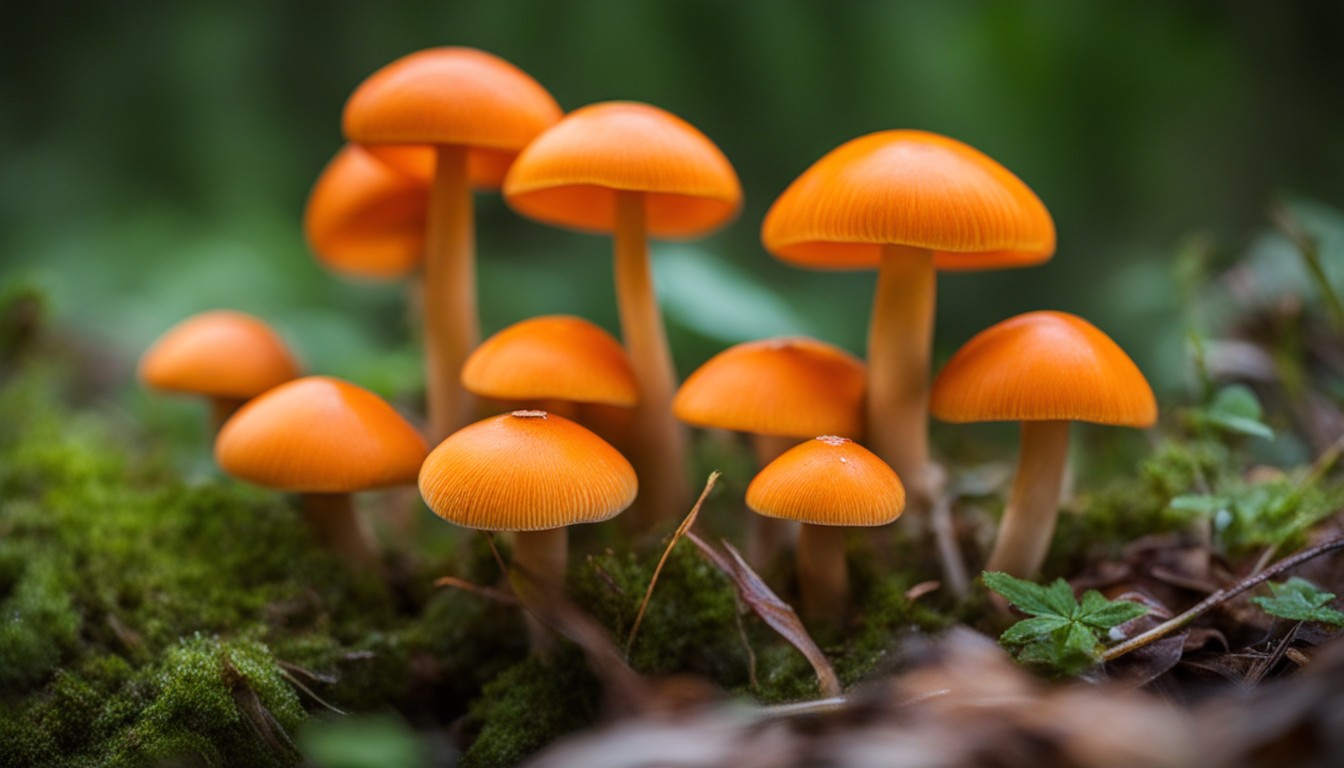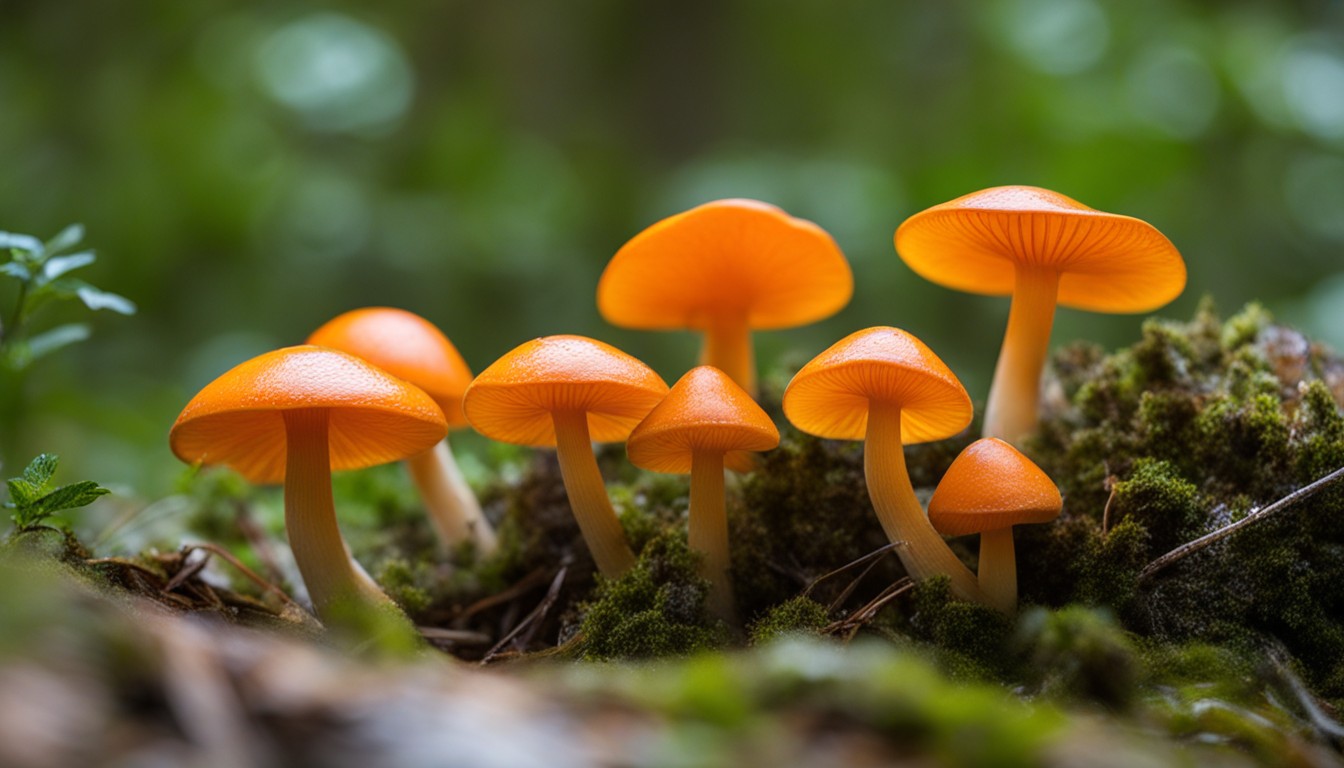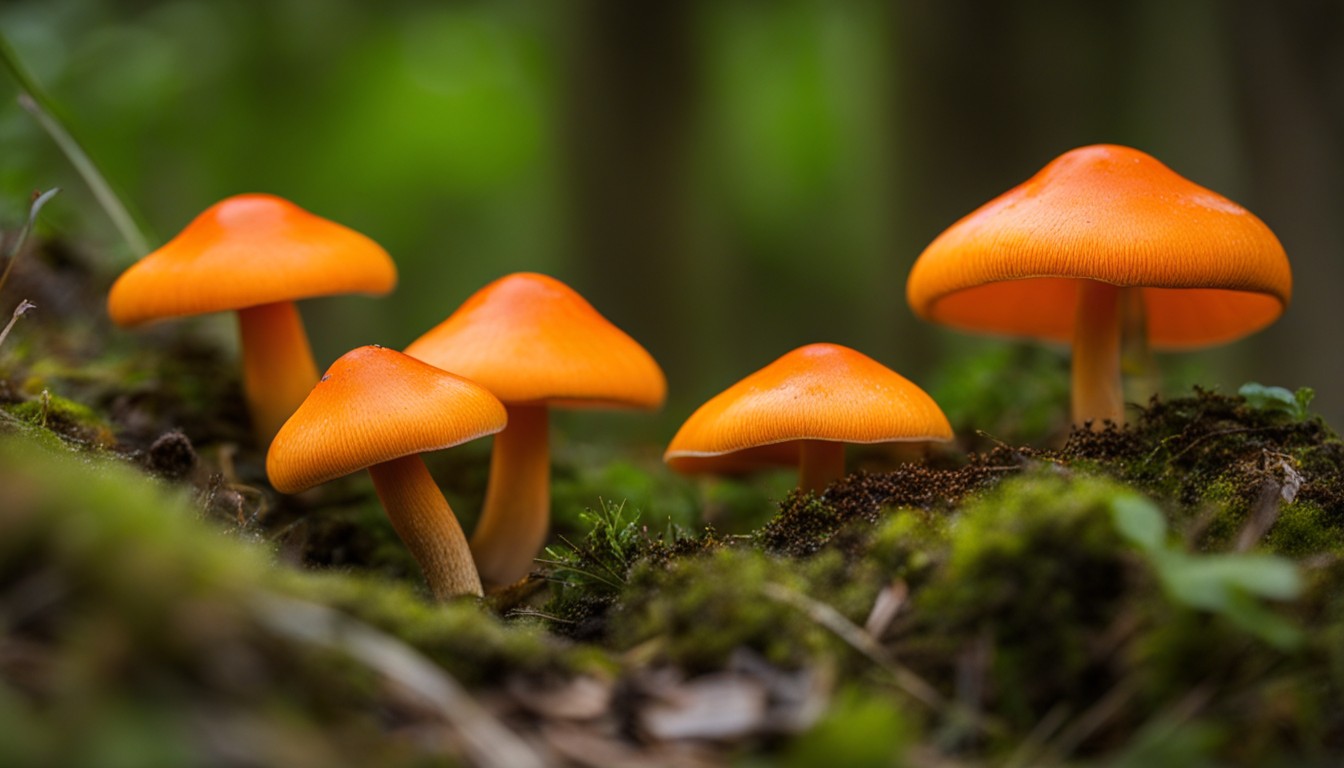Orange mushrooms are a fascinating and diverse group of fungi found in the beautiful state of Minnesota. In this comprehensive guide, we will explore the various types of orange mushrooms that can be found in Minnesota and provide valuable tips on how to identify them. From the iconic Orange Peel Fungus to the striking Chicken of the Woods, we will delve into the unique characteristics and habitats of these mushrooms. Additionally, we will discuss the safety considerations and culinary potential of orange mushrooms, offering suggestions on how to enjoy them responsibly. Whether you are an avid mushroom enthusiast or simply curious about the fascinating world of fungi, this guide will serve as an invaluable resource for discovering and appreciating orange mushrooms in Minnesota.
Introduction to Orange Mushrooms in Minnesota
In Minnesota, the diversity of orange mushrooms found in the wild showcases the region’s remarkable ecological variety. From small, intriguing species like the Orange Mycena and the vibrant Jack-o’-Lantern Mushroom to the large, iconic Fly Agaric, the array is vibrant and rich.
The distinctive habitats and seasonality of these fungus species are an essential part of the Minnesota ecosystem. Depending on temperature, moisture, and the type of substrate, mushrooms appear during different periods, fostering a dynamic and continuous fungal bloom cycle throughout the year.
- Orange Mycena: Tiny, deep orange fungus commonly found among leaf litter.
- Jack-o’-Lantern Mushroom: Bright orange, bioluminescent species often seen in large, eerily glowing clusters.
- Fly Agaric: Iconic orange and white mushroom, often depicted in pop culture.
- Variations in Habitat: Certain species of orange mushrooms thrive in leaf litter, while others prefer tree bark or fallen logs.
- Seasonality: Many orange mushrooms can be primarily found in fall, although other species appear throughout the year depending on weather conditions.
The Importance of Proper Identification
Gauging the correct identity of orange mushrooms is crucial not only to avert the negative impacts of misidentification, such as potential health risks, but also to sustain ethical and conscious foraging practices, which contribute to the preservation of Minnesota’s diverse ecosystems.
Why Proper Identification Matters
Proper identification of mushrooms is vital, as incorrect assumptions can lead to potentially deadly consequences like toxic ingestion. Misidentifying and consuming a poisonous species can cause severe health implications, from mild gastro-intestinal discomfort to life-threatening conditions.
Additionally, orange mushrooms play a role in maintaining ecosystem balance. Incorrect identification may cause some species to be unnecessarily removed, disrupting natural processes and negatively affecting local flora and fauna.
Common Misidentifications to Avoid
A notable instance of an orange mushroom misidentification occurred when the deadly Jack O’Lantern was mistaken for the edible Chanterelle. This highlighted the gravity of understanding the distinctions among similar looking fungi. Variance in stem structure and gill arrangement of these mushrooms serve as key differentiators.
With mushroom identification, minute distinctions such as stem, gill arrangement, spore color, and texture are critical for differentiating toxic from edible species, emphasizing the need for meticulous scrutiny.
Cases like edible Orange Mycena being confused with the toxic Orange Mock Oyster Mushroom reiterate the importance of careful scrutiny during identification. Minute differences such as decurrent gills in Orange Mock Oyster as opposed to adnate to slightly decurrent gills in Orange Mycena can prevent mishaps.
In the field of Mycology, challenges abound in identifying orange mushrooms accurately. A prototypical example is separating Fly Agaric, a toxic species with its iconic orange-red cap, from benign counterparts. This hurdle calls for a deeper understanding of spore print color and habitat preferences.
It’s common to misidentify Coral Fungi for Orange Fairy Club due to their similar overall appearance. However, keen observation reveals that Coral Fungi possess branch-like structures, unlike the latter. Such instances reinforce the need for a meticulous approach in identification.
Even experienced foragers find it tough to differentiate between Woolly Waxcap and Orange Peel Fungus, thanks largely to their closely similar hues. It’s the texture discrepancy, with Woolly Waxcap having a dry, hairy appearance and Orange Peel being moist and smooth, that sets them apart.
Characteristics of Orange Mushrooms

Orange mushrooms boast a variety of morphological features that aid in their identification. Key distinguishing factors are their vibrant orange hue, diverse cap shapes, characteristics of their gills, spore patterns, unique stem structure, along with distinct odors and tastes.
Understanding the life cycle of these orange species found in Minnesota can offer a fascinating dive into the world of mycology. Their growth is intimately tied to forest ecosystems and soil conditions, and careful observation can help clarify their seasonal patterns and environmental preferences.
Color and Shape
Orange mushrooms in Minnesota display a diverse array of hues and shapes – each subtly recalling its unique identity, habitat, and potential use. A keen understanding of these characteristics can offer a wealth of information about the mushroom’s classification and edibility.
- Recognize the varying hues from subtle peach to vibrant tangerine contrasted against Minnesota’s woodland backdrop.
- Identify shape nuances such as convex or flat caps, delicate or stubby stems, suggesting their development stages.
- Note how certain species, such as the Orange Mycena, have bell-shaped caps, distinguishing them from others.
- Consider the size – larger varieties such as the Jack-o’-Lantern mushroom can grow sizeably, a characteristic often linked to toxicity.
- Observe if the cap edges are curled or flat, as this can indicate a young or mature mushroom.
Gills and Spore Pattern
A key identifier of orange mushrooms in Minnesota lies in the observation of their gill arrangement and spore patterns. This examination reveals unique traits that set them apart from other mushroom varieties.
- Color: Orange mushrooms often have gills of a lighter or darker hue compared to their cap.
- Regularity: The gills’ regularity or irregularity could help in verifying the orange mushroom’s species.
- Spore Pattern: Each mushroom gives out a distinct spore print color which is crucial for accurate identification.
- Attachment: Determine if the gills are free, attached, or decurrent to the stem.
- Density: Gauge the closeness of the gills, as it varies among different mushroom types.
Stem and Cap
The stem and cap, distinct features of fungi, are paramount in correctly identifying Minnesota’s orange mushrooms. Each mushroom’s unique attributes reveal much about its identity.
- Orange mushrooms often have robust, tall, and fibrous stems marked by ridges or scales.
- The caps usually exhibit a convex or flat shape, frequently boasting an elegant umbonate (nipple-like) center.
- The surface texture of the cap may vary – some showcase a smooth, silky appearance, while others offer a velvety, coarser texture.
- Mature orange mushrooms may have caps which curl upwards, exposing a lighter colored, margin underside.
Odor and Taste
Odor and taste play pivotal roles in determining the edibility of orange mushrooms occurring in the wilds of Minnesota. These characteristics can greatly help in confirming their safety and palatability, adding an extra layer to their proper identification.
When it comes to odors, certain orange mushrooms emit memorable scents. Some might carry an aromatic, pleasant smell, indicating edibility, while others may have a foul, repellent stench, often signaling potential toxicity or inedibility.
Similarly, taste is a vital factor. Although not all mushrooms should be tasted due to potential toxicity, certain identifiable and typically safe species exhibit a distinct taste profile from sweet and nutty, to bitter, or even metallic.
Flavor investigation, however, must be conducted responsibly. If an orange mushroom hasn’t been positively identified and declared safe, tasting it is strongly discouraged. It’s essential to consider the potential risks and consequences.
Both scent and taste strongly influence our perception and decision of whether to cook up or shun a particular mushroom. A wise forager uses these senses, combined with other identification methods, to enjoy and appreciate orange mushrooms responsibly.
Habitat and Growing Conditions

Orange mushrooms flourish in the abundant forest and wooded regions across Minnesota. Their preference for damp, nutrient-rich soil and the shadows cast by trees provide the perfect habitat for growth.
These fungi demonstrate remarkable adaptability. They thrive in diverse microclimates, given the presence of necessary elements such as moisture and organic matter. Identifying such conditions allows for successful mushroom foraging or cultivation.
Forests and Wooded Areas
In the lush green woods of Minnesota, orange mushrooms peek brightly from the undergrowth. Preference leans toward deciduous forests, where these fungi thrive in the damp, nutrient-rich environment crops up around rotting logs or leaf clutter. They seek refuge in the shadows of mighty oaks or under the gentle canopy of maples, hinting at nature’s cycle of decay and renewal.
These fungi form a symbiotic relationship with the surrounding ecosystem. In the forests’ complex network of life, they play a vital role, aiding in decomposition and nutrient cycling. As decomposers, they breakdown dead organic material, adding to the natural compost that nourishes the forest floor.
Next time you embark on a leafy trail, glance beneath the ferns and foliage; you’re likely to encounter a cluster of vivid orange caps, signifying the growth of orange mushrooms. They love the semi-shade environments, thriving under the dappled forest’s lights, the sun bouncing off their caps in shallow pools.
When it rains, it’s a boon for these fungi. The dampness initiates their spore release. Many species require the moist environment provided by Minnesota’s forests to reproduce successfully. So, a rainy trek might increase your chances of finding these vibrant species.
In essence, the forests and wooded areas of Minnesota provide habitat, nourishment, and ideal growing conditions for these orange mushrooms. With intricate symbiotic relationships, these areas teem with biodiversity, where these fungi significantly contribute, urging the forest to blossom energetically. Aided by rainfall and shade, these fungi are a testament to nature’s balance, dotting the forest floor with specks of vibrant orange.
Soil and Moisture
Orange mushrooms have their own specific soil preferences crucial for their thriving. They require a rich substrate, mostly leaf litter or woody debris. Differences in soil composition can notably influence the type, size, and color of the fruiting bodies.
The soil pH also greatly matters. Slightly acidic to neutral soil, with pH between 6 and 7, is generally ideal for successful mushroom cultivation. Any drastic deviation can prevent or hinder the development of these fascinating fungi.
Apart from soil conditions, adequate moisture plays a significant role in orange mushroom’s life cycle. This is because mushrooms are about 90% water and require consistent dampness for optimal growth.
Excessive moisture, however, can lead to waterlogged conditions which are detrimental to mushroom growth. Hydration must be managed wisely, ensuring the soil remains moist but not swamped, to facilitate healthy fructification.
Periods of rainfall followed by warm, humid days tend to trigger mushroom fruiting. Weather forecasts can be useful indicators of when to expect a fruiting surge. Thus, understanding and adapting to these nuances of soil and moisture can enrich your mushroom foraging experience in Minnesota.
Potential Health Risks and Safety Precautions
The vibrant hue of orange mushrooms, while visually appealing, can veil potential health risks including allergenic reactions or toxicity if they are not correctly identified and properly handled. A healthy respect for these fungi is crucial to ensure safe foraging and consumption.
Safety precautions when hunting for orange mushrooms include learning to identify common lookalikes, always wearing gloves when handling unknown specimens, avoiding consumption until a positive identification has been made, and cross-checking resources when in doubt. These precautions will allow amateur mycologists to enjoy their hobby without fear or harm.
Allergies and Toxicity
Similar to many plant-based foods, orange mushrooms can incite allergic reactions, especially in individuals with heightened sensitivity. These reactions typically range from mild skin rashes to severe anaphylactic responses.
Despite their appealing hue, orange mushrooms may carry a degree of toxicity, underscoring the importance of correct identification. Ingestion of certain toxic varieties can lead to symptoms ranging from mild stomach upset to serious organ damage.
Handling and Consuming Safely
When handling orange mushrooms, it is paramount to wear gloves to protect your skin from potential irritation or allergenic reactions. Always remember to avoid touching your face or eyes during the process until you’ve thoroughly washed your hands.
Before you consume any mushroom, verification of its identification is crucial. The guidance of a seasoned mycologist or an authoritative identification guide is indispensable to avoid consuming potentially toxic species.
Cooking orange mushrooms properly is another essential safety measure. Certain varieties could contain compounds that are unpalatable or difficult to digest when raw, but these compounds are often neutralized by heat.
Ways to Enjoy Orange Mushrooms

Delighting in the wild, orange mushrooms from Minnesota provide an exciting culinary adventure. When properly identified and prepared, they can be a tasty addition to various recipes. From risottos to sautés, their unique flavor and texture can enhance dishes, while taking you on a gastronomic journey right from the forest to your fork.
Culinary Uses and Recipes
Among the recipes inspired by nature, Orange Mushroom Risotto is a fan-favorite. The inherent umami taste of these mushrooms significantly enhances the earthy flavors of this classic Italian dish, thus delivering a unique gastronomic experience.
Orange mushrooms are not just about their intriguing color, but also their robust flavor that has led to the creation of innovative dishes such as the Orange Mushroom Tart – a delightful blend of savory and slight sweetness.
Another interesting culinary creation is the Orange Mushroom Soup. In this hearty dish, the mushrooms’ distinct nutty flavor amalgamates perfectly well with the creamy soup base, creating a comforting bowlful.
Aside from traditional cooking, adventurous foodies are exploring the unique properties of orange mushrooms in pastry making, leading to fascinating creations like Orange Mushroom Muffins, where the peculiar taste of the mushrooms compliments the sweet batter.
Preservation and Storage Tips
For long-lasting goodness, refrigerating is the most effective method. Store in a brown paper bag to allow air circulation, preventing moist conditions that expedite spoilage. Never use plastic bags as mushrooms need to breathe.
To unlock freshness, blanching and freezing orange mushrooms can be key. Simply blanch for a few minutes, cool, pat dry and freeze. Let the mushrooms dry out completely before freezing to prevent ice crystal formation.
Another approach, dehydration, is traditional but very effective. The process accentuates the flavor, making them excellent for seasoning soups and sauces. The key to proper dehydration: a cool, dark place.
For a more exotic method, pickling mushrooms can provide an interesting flavor twist. Always note, though, proper sterilization of jars and lids is crucial when pickling anything, not just mushrooms, to prevent any health risks.
Frequently Asked Questions
What are orange mushrooms?
Orange mushrooms are a diverse group of fungi that exhibit vibrant orange hues in their caps, stems, or both.
How can I identify orange mushrooms in Minnesota?
Identifying orange mushrooms in Minnesota requires careful observation of their color, shape, size, and other distinguishing features, along with consulting field guides or experts for accurate identification.
Are all orange mushrooms in Minnesota safe to eat?
While some orange mushrooms in Minnesota are edible and delicious, others can be toxic or inedible. It is crucial to properly identify mushrooms and consult experienced foragers or mycologists before consuming any wild fungi.
Can I find orange mushrooms year-round in Minnesota?
Orange mushrooms in Minnesota are typically more abundant during the late summer and fall months when conditions are favorable for their growth. However, specific mushroom species may have different fruiting seasons.
Where can I find orange mushrooms in Minnesota?
Orange mushrooms can be found in various habitats such as forests, woodlands, and even in urban areas with suitable growing conditions. Exploring different regions and ecosystems can increase your chances of discovering a wide range of orange mushroom species.
Are there any specific safety precautions when mushroom hunting?
Yes, it is essential to follow proper safety precautions when mushroom hunting. This includes wearing appropriate clothing, using a mushroom knife or basket, avoiding consumption of unidentified mushrooms, and consulting professional foragers or mycologists for guidance.
Can I cultivate orange mushrooms in Minnesota?
While some species of orange mushrooms can be cultivated, it is a complex process that requires specific knowledge and conditions. It is recommended to seek guidance from experts or join local mycology groups for more information on cultivating orange mushrooms.
How can I incorporate orange mushrooms into my meals?
Orange mushrooms can add unique flavors and textures to various culinary dishes. However, it is crucial to ensure proper identification, as some species may require special cooking techniques or specific preparation methods. It is always advisable to consult reputable mushroom cookbooks or experienced foragers for safe and delicious recipes.
Are there any conservation efforts for orange mushrooms in Minnesota?
As mushrooms play a vital role in ecosystems and their conservation is essential, various organizations and mycology enthusiasts in Minnesota actively promote the conservation and sustainable harvesting of mushrooms. Participating in local mushroom clubs or contacting nature conservation groups can provide opportunities to learn more and engage in conservation efforts.
Conclusion
The journey of identifying and enjoying orange mushrooms in Minnesota is an engaging, educational adventure enriched by the vibrant beauty of these fungi. Each mushroom is an intriguing world in itself, opening a window to a hidden realm of intricate ecological interactions and aesthetic appeal.
Embrace the world of orange mushrooms in Minnesota with a new sense of understanding, respect and enjoyment. Let the knowledge of proper identification, safe handling, and diverse culinary applications enrich your experiences and foster a solid connection with the natural world around you.
- Endnote: The examination of orange mushrooms enhances awareness of the Minnesota’s rich biodiversity.
- Reflection: A deeper understanding and appreciation of the natural world can be drawn from the study of orange mushrooms.
- Final Thoughts: Encourage exploration and foster respect for the environment through practicing responsible foraging.
- Embrace: As the vibrant world of orange mushrooms unfolds before you, become an active participant in your own learning journey.

